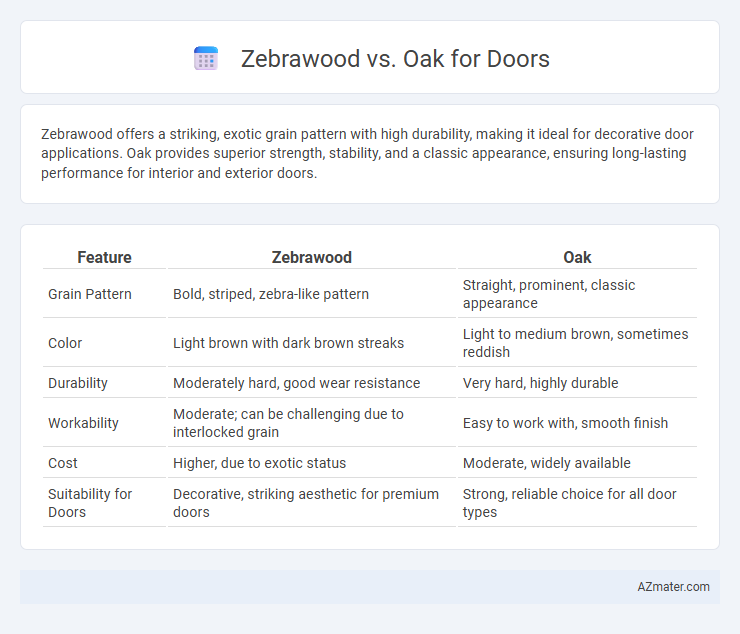Zebrawood offers a striking, exotic grain pattern with high durability, making it ideal for decorative door applications. Oak provides superior strength, stability, and a classic appearance, ensuring long-lasting performance for interior and exterior doors.
Table of Comparison
| Feature | Zebrawood | Oak |
|---|---|---|
| Grain Pattern | Bold, striped, zebra-like pattern | Straight, prominent, classic appearance |
| Color | Light brown with dark brown streaks | Light to medium brown, sometimes reddish |
| Durability | Moderately hard, good wear resistance | Very hard, highly durable |
| Workability | Moderate; can be challenging due to interlocked grain | Easy to work with, smooth finish |
| Cost | Higher, due to exotic status | Moderate, widely available |
| Suitability for Doors | Decorative, striking aesthetic for premium doors | Strong, reliable choice for all door types |
Introduction to Zebrawood and Oak
Zebrawood, known for its distinctive striped grain pattern and rich brown hues, offers a unique and exotic aesthetic ideal for statement doors. Oak, prized for its strength, durability, and classic grain texture, provides a timeless and sturdy option for door construction. Both woods deliver excellent performance, with Zebrawood excelling in visual appeal and Oak standing out for its resilience and traditional charm.
Key Characteristics of Zebrawood
Zebrawood is prized for its distinctive bold, striped grain pattern and high durability, making it a striking choice for doors that require both strength and visual appeal. Its dense, hard texture resists wear and impact better than many hardwoods, including oak, while offering a unique exotic look that enhances modern and traditional architectural styles. Zebrawood's natural oils provide resistance to moisture and pests, contributing to its longevity in door applications compared to the more common oak.
Key Characteristics of Oak
Oak doors are renowned for their exceptional durability and strength, making them ideal for high-traffic areas and exterior use due to their resistance to wear and impact. The wood features a prominent grain pattern with coarse texture, providing a classic and elegant appearance that complements various architectural styles. Its natural resistance to moisture and decay enhances longevity, while its ability to accept stains and finishes allows for versatile customization.
Appearance and Aesthetic Comparison
Zebrawood features a striking, bold grain pattern with contrasting dark stripes, creating a unique and exotic aesthetic ideal for statement doors. Oak offers a more traditional, warm appearance with a fine, consistent grain that ages gracefully, providing timeless elegance. The distinct visual impact of Zebrawood makes it suitable for modern, luxurious designs, while Oak's versatile look complements both classic and contemporary door styles.
Durability and Strength Differences
Zebrawood offers high durability with a Janka hardness rating of about 1,340, making it resistant to dents and wear, while oak, especially red oak, has a slightly lower hardness rating around 1,290 but provides excellent strength and stability. Oak doors exhibit superior resistance to warping and splitting due to their dense grain structure, making them a preferred choice for long-lasting door construction in varied climates. Zebrawood's unique striped grain pattern enhances aesthetic appeal but may require more maintenance to preserve its surface integrity compared to oak.
Workability and Ease of Fabrication
Zebrawood offers moderate workability with a coarse texture that can challenge intricate carving but machines well when sharp tools are used, providing a distinctive striped aesthetic perfect for door panels. Oak, known for its hardness and dense grain, is easier to sand and stain, making it a preferred choice for door fabrication due to its excellent durability and finish adaptability. Both woods require pre-drilling for fasteners to avoid splitting, but oak's uniform grain generally ensures smoother cutting and nail holding during assembly.
Cost and Availability
Zebrawood doors generally have a higher cost due to their exotic nature and limited availability compared to oak doors, which are widely accessible and more budget-friendly. Oak is abundant in North America and Europe, making it a popular choice for cost-effective and readily available door materials. Zebrawood's striking grain pattern and rarity increase its price and can lead to longer lead times, whereas oak provides a consistent supply for most door manufacturing needs.
Maintenance and Longevity
Zebrawood offers moderate maintenance needs due to its natural oils that resist moisture and insects, making it suitable for doors in humid environments, though it requires regular sealing to maintain its appearance. Oak is highly durable and more resistant to wear and tear, needing less frequent maintenance but benefiting from periodic refinishing to prevent surface damage. Both woods provide excellent longevity for doors, with oak typically lasting longer under heavy use due to its dense grain structure.
Environmental Impact and Sustainability
Zebrawood is a tropical hardwood primarily sourced from West Africa, known for its striking grain but associated with higher environmental concerns due to slower growth rates and limited regional sustainability certifications like FSC. Oak, widely available in Europe and North America, benefits from more robust reforestation programs and sustainable forest management practices, making it a more eco-friendly choice for doors. Choosing oak supports reduced carbon footprint and preservation of biodiversity, while zebrawood's exotic appeal often comes with greater ecological risks and potential for illegal logging.
Which Wood Is Best for Your Door?
Zebrawood offers a striking, exotic grain with high durability, making it ideal for doors that require visual impact and resistance to wear. Oak provides excellent strength, stability, and a classic appearance, suitable for doors that prioritize longevity and traditional aesthetics. Choosing between Zebrawood and Oak depends on whether you prioritize bold design and unique texture or time-tested durability and a familiar look for your door.

Infographic: Zebrawood vs Oak for Door
 azmater.com
azmater.com